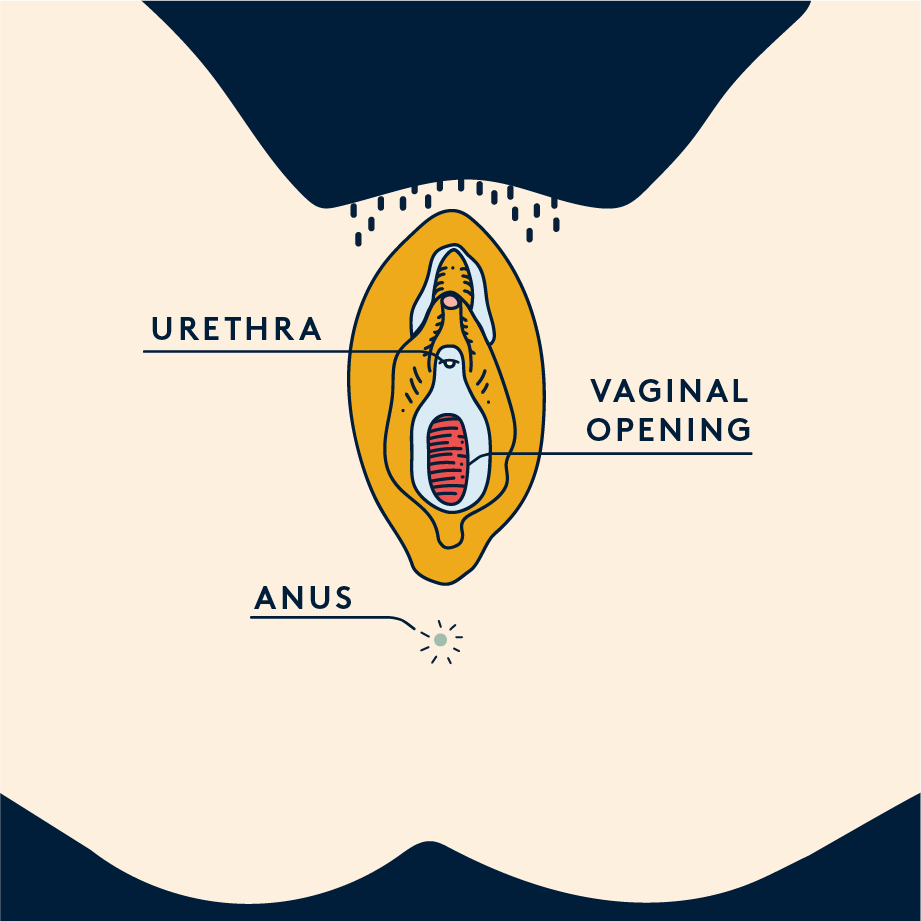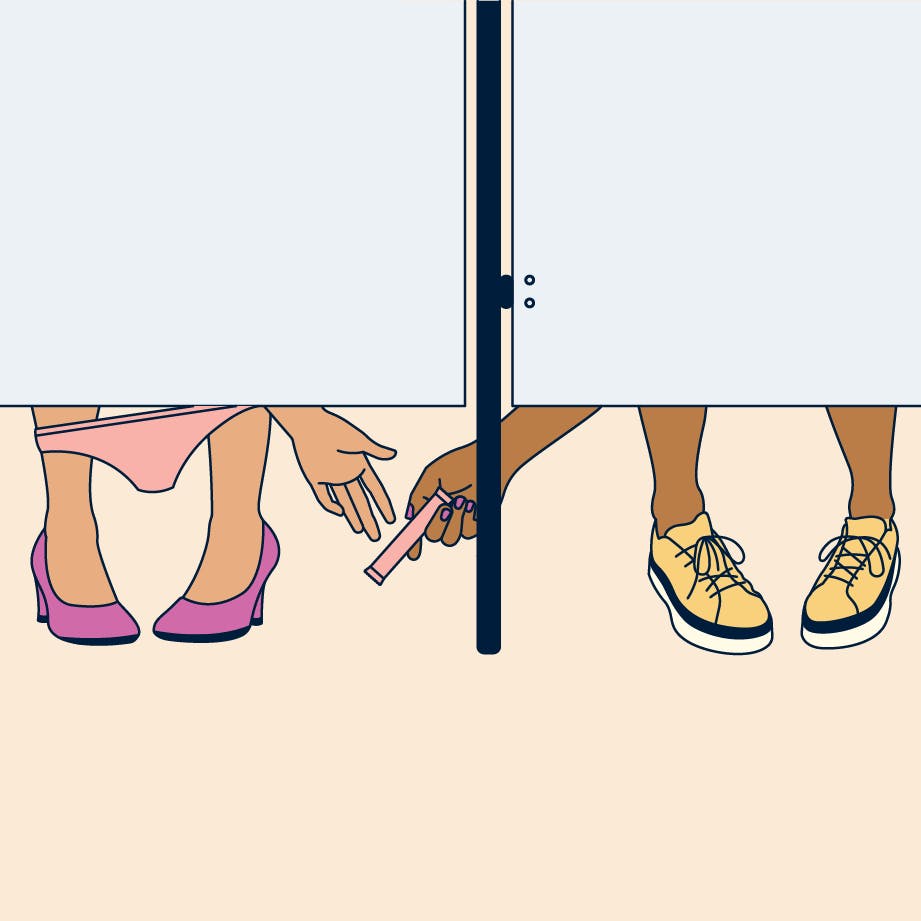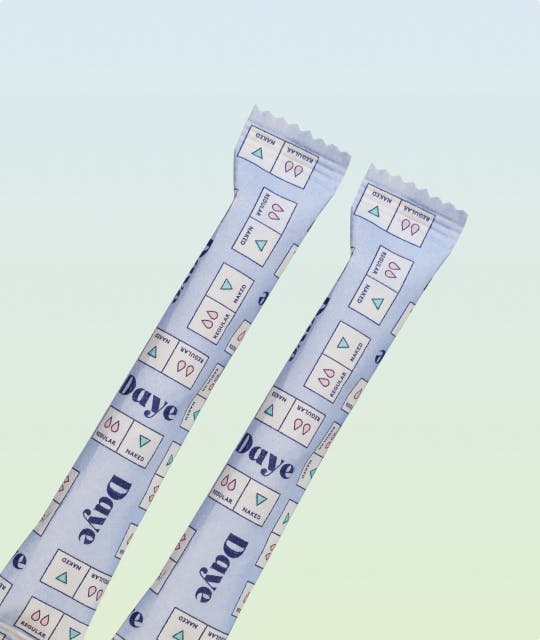Table of contents
1. But which hole does the tampon go in?
2. Step 1: Choosing the right tampon
3. Step 2: Get into a comfortable position
4. Step 3: Locate the vaginal opening with your tampon
5. Step 4: Insert the tampon
6. Why does it hurt when I use tampons?
7. How to remove your tampon?
8. How often should I change my tampon?
9. Conclusion.
Written by Valentina Milanova
Medically reviewed by Sarah Montagu (RN DFSRH, BSc)
Illustrated by Erin Rommel Sabrina Bezerra
Tampons have become one of the most popular menstrual products available, with an estimated 80% of women & AFAB folks using tampons
While there are plenty of factors that go into why someone would prefer to use pads (eg. cultural reasons, comfort, accessibility), one common reason is that a lot of people don't know how to insert a tampon properly. There's no shame in this at all – plenty of us have experienced discomfort when inserting a tampon or maybe have looked at the applicator with a bit of fear.
This is why we've put together this step-by-step guide on how to insert a tampon with ease. Read on and we’ll answer all your questions about using tampons and talk you through every step of the process.

But which hole does the tampon go in?
Like we said, there's no shame in not knowing how tampons work and there's definitely no shame in not knowing where to insert it. The vagina is a beautiful, yet sometimes confusing and unnecessarily stigmatised, part of our bodies. So, before we go into how to insert a tampon, you'll need to know where it should be going.
There are three holes you'll need to be aware of: the urethra, the vagina, and the anus. The vagina is located between the urethra and anus and is the opening that leads to the cervix and then the uterus – which is where blood comes from during the menstrual cycle.
You might be thinking, 'What happens if I accidentally insert the tampon into my urethra?' but don't worry! The urethra has a very small opening so it's basically impossible for a tampon to fit inside it.
If you're still a bit confused, we recommend taking a small mirror and having a look around yourself. Hold the mirror close to your genital area, making sure to angle it so you have a clear view. You can have a feel around and separate the labia – the 'lips' around the vagina and urethra – to help you understand the area and where the tampon should go.
Step 1: Choosing the right tampon
Choosing the right tampon is crucial in making sure you're comfortable throughout your menstrual cycle. Not all tampons are created equal. Aside from the differences in feel and material, you'll also find tampons that provide different levels of absorbency depending on how heavy or light your menstrual flow is.
Here at Daye, our tampons can be found in two different tampon sizes: regular and super. These two labels indicate how much menstrual blood the tampon is able to absorb. Our tampons are also 100% organic and sanitised which reduces your risk of TSS and vaginal infections.
Regular tampons offer regular to light absorbency, which makes them a great option for days you're experiencing light to medium menstrual bleeding.
Super tampons are designed to be used for your heavy flow days and will reduce the chance of tampon leaks.
You can also find tampons that come either with or without a tampon applicator, the latter of which usually features a plastic or cardboard applicator. Some people find it easier to insert a tampon with an applicator, which is why all our tampons feature a super smooth bio-based sugarcane applicator, but this all comes down to personal preference.
Step 2: Get into a comfortable position
Before you get started, make sure you wash your hands to prevent any dirt or bacteria from getting near your vagina. Foam up the soap well and make sure to rub your thumbs and the backs of your hands.
After washing your hands, you'll need to get comfortable. Some people put one foot on a closed toilet seat or bathtub, some prefer to sit on the toilet with their knees spread apart, while others prefer a slightly squatting position. You might also find it convenient to lay on your bed and lift your legs in the air.
Whichever way you decide to go for, make sure you find the most comfortable position for inserting a tampon as this will help you insert it correctly.
Step 3: Locate the vaginal opening with your tampon
If you read our section on locating your vagina and vaginal opening, you'll already know where you'll need to insert the tampon. But just in case, you can also keep your mirror nearby to help guide you.
Take your new tampon and place the tip at your vaginal opening. You'll want to point your tampon at a slight angle, pointing towards your lower back instead of straight up. This is because the vaginal opening doesn't actually go straight up into your body but instead sits at a diagonal angle.
You might need to experiment a bit to find the right angle for insertion as everyone's vagina is different, so don't stress and take your time. You can also use your index finger and pointer finger to move the labial lips so you have a clearer view of the vaginal opening. If you are inserting a tampon for the first time, you might need to try 2-3 times before you get it right. After that, it’s like riding a bike - it becomes intuitive and you can do it on autopilot.

Step 4: Insert the tampon
After locating the vaginal opening, it's now time to insert the tampon. Most women & AFAB folks find this step to be the most intimidating part, especially when it's their first time, so make sure to take a deep breath and relax.
Tampons with applicators
If you're using a tampon with an applicator, you'll see that one end is bigger and contains the white cotton tampon. This bigger end is the tip that will go inside your vagina. The other end should have the string surrounded by a hollow, small tube – this is the part that will push the tampon out of the applicator.
Take the tampon in one hand and gently insert it into your vaginal opening until you reach the small indent that's halfway up the applicator. Hold on to that indent with two fingers and start pushing the tampon applicator's smaller inner tube toward you with your index finger.
As you push, the tampon will slide out of the applicator and inside your vagina. Continue to gently push until it stops, then simply remove the applicator and dispose of it in the bin. If the tampon is in deep enough, you shouldn’t feel it at all. If you can still feel your tampon, then try to insert it a bit deeper.
The string should now be hanging down from your vagina. If you notice part of the tampon is still sticking out, you can gently push the tampon until it is fully inserted.
Non-applicator tampons
If you've opted for a non-applicator tampon, it's still a very simple procedure but might be slightly more tricky compared to using a tampon applicator.
Once you've removed the tampon wrapper, hold the string and pull it tight from left to right and top to bottom. This will widen the base and create a protective pocket for your finger. Put your index finger in this pocket and hold the tampon between your thumb and middle finger.
Push the tampon inside your vagina with your index finger, and then slide your finger out. The tampon string should now be hanging outside your vagina.
Congratulations, you've successfully inserted your tampon! Remember, if you're inserting a tampon for the first time then don't rush the process. Your first tampon is usually a bit more uncomfortable so take your time inserting it properly and comfortably.
Why does it hurt when I use tampons?
If you're using a tampon for the first time, it's super important to know how to insert a tampon properly to avoid any pain and discomfort. When properly inserted, tampons shouldn't hurt, in fact you might even forget it's in there at all.
But if you notice persistent pain every time you insert a tampon, there might be some complications that can prevent you from inserting the tampon. One of these includes a condition called vaginismus. Vaginismus is when the muscles around your vaginal opening squeeze so hard that nothing can enter the vagina. This squeezing is involuntary, which means you can't control it, and can sometimes be a trauma response. Fortunately, you can treat vaginismus by going to see your gynaecologist or a specialist.
Some people are also born with a very small opening in their hymen, which is the thin ring of tissue that surrounds the vaginal opening. If your hymen partially blocks the opening, it can prevent your tampon from properly entering. It's a relatively easy fix, where a gynaecologist will simply numb the area and conduct a quick and simple procedure. If you’re in the UK you’d need to speak to your GP and request a gynaecology referral.
Essentially, if you notice you're having trouble inserting your tampon every time you try, we recommend going to your GP or gynaecologist to get checked up. If you find that tampons aren't really for you after all, our organic Bamboo Pads are another great alternative. Just like tampons, they also come in different absorbency levels and are fully biodegradable to help reduce your environmental impact. All in all, they're just as effective as tampons and the choice between the two is all up to your preferences.
How to remove your tampon?
Once you're ready to remove your tampon, return to that same comfortable position you were in when you inserted the tampon earlier. Hold the end of the tampon string and gently pull the tampon until it comes out.
Tampons that have absorbed plenty of blood and menstrual fluid should slide out fairly easily, but if it hurts it might be too dry which means you'll need to wait a bit longer before removing it – you can leave a tampon in up to eight hours but don’t leave it any longer than this. Once you've removed the tampon, you can dispose of it in the bin. Some people prefer to wrap the tampon in several layers of toilet paper before they dispose of it in the bin. Just make sure to wash your hands after.
When removing tampons, it's important to remember that you can't flush them down the toilet. Tampons can clog the plumbing system and potentially harm the environment, too.

How often should I change my tampon?
Many people choose to wear tampons for just a few hours at a time for convenience, especially those who lead a more active lifestyle. We recommend leaving your tampon inside for four to eight hours, depending on how heavy your flow is. If you're having a heavy day, you'll need to change your tampon more frequently to prevent any leaks.
Make sure you don't leave the tampon in for no more than eight hours as this can lead to Toxic Shock Syndrome, a condition that is caused by bacterial toxins that can begin to develop when tampons are left in for too long. While the condition itself is pretty rare, affecting 1 in every 100,000 people, you should still be cautious and remember to change your tampons frequently to avoid it.
Conclusion.
Using your very first tampon can feel pretty stressful at first, but we hope this step-by-step guide to tampon insertion has made you feel way more comfortable about using tampons. If you're looking for more information, we also have plenty of other guides to help you understand your vagina, menstrual cycle, and overall well-being better. Whether you're looking for ways to manage period pain, or are curious about how menstruation affects your body, our Vitals blogs are here to help you make more informed decisions about your body.







